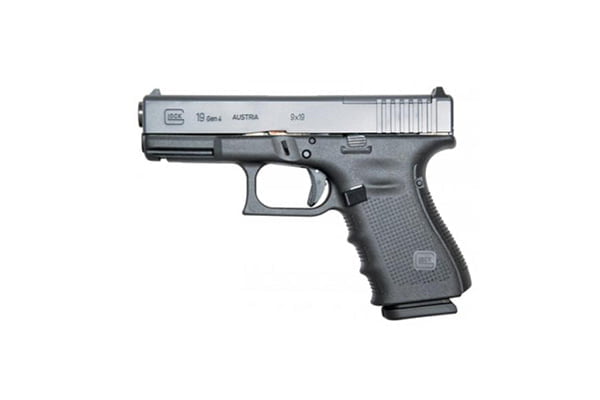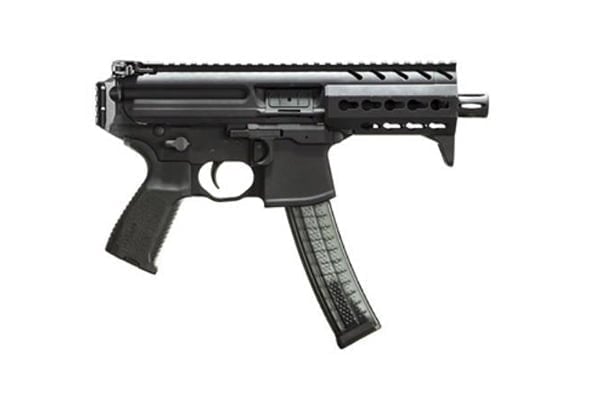

It’s hard to pick your first gun. The key lies in striking the perfect balance between safety, ease of use, and reliability. In an ideal world you’d invest in hours of training with a plastic gun, followed by weeks of training with a 22LR pistol. But that’s not how life works. People shopping for their first gun tend to have a reason, and so you just want the best handgun to defend your home and family if the dreaded moment should ever come.
Glock Handguns: Simplicity and Popularity
Glock, a name synonymous with reliability and straightforwardness, reigns supreme in the handgun market. Law enforcement, military personnel, and civilians alike love the Glock 19, Glock 17 and Glock 43x for concealed carry. Glocks have earned their stripes and are the go-to pistol for any government agency that didn’t go for the Sig Sauer P320/Sig M17 line.
Simplicity With a design ethos rooted in simplicity, Glocks boast fewer parts than many other handguns. That translates into insane reliability and a gun that you can famously drag through the mud and it will come on firing. It’s one of the few guns you can basically ignore the maintenance and it will still work when you need it to. You should still maintain it, of course, and taking apart and cleaning a Glock is a breeze. So it’s a great option for those new to firearms.
One problem, or at least a quirk of Glock handguns is their lack of a manual safety. This feature is a double-edged sword, teeming with both advantages and potential drawbacks.
Pros:
- Rapid Deployment: The absence of a manual safety means no fiddling in critical moments. You can swiftly draw and fire, a crucial advantage in self-defense scenarios.
- No Extra Steps: In high-stress situations, the brain can fumble. Glocks eliminate the need to remember disengaging a safety, ensuring you’re ready to act when seconds count.
Cons:
- Trigger Discipline is Paramount: Without a manual safety, maintaining disciplined trigger control is imperative. Keeping your finger off the trigger until ready to shoot is non-negotiable.
- Perceived Risk: Some users feel a heightened sense of caution without an external safety, fearing accidental discharges. Proper training and a good holster at all times can mitigate this concern, instilling confidence and competence.
Revolvers: Pros and Cons
Revolvers, the stalwarts of the handgun universe, are cherished for their reliability and no-nonsense operation. They’re old school, basically never fail and they are kind of cool. But, well, they’re old school. They hold less rounds, they’re built around older and expensive calibers and they’re normally a heavy lump of a gun.
Pros:
Reliability:
- Simplicity in Design: Revolvers operate with a basic mechanism, less prone to the whims of malfunction. This reliability is golden for beginners, ensuring consistent performance.
- Trustworthy Functionality: The likelihood of a revolver jamming is minimal, providing peace of mind that it will work when needed most.
Ease of Use:
- Straightforward Mechanics: With most revolvers utilizing a double-action mechanism, the process is intuitive – the trigger pull cocks and releases the hammer, simplifying the user experience.
- Low Maintenance: Fewer parts mean revolvers are easier to clean and maintain, a boon for those not keen on frequent disassembly.
Cons:
Capacity:
- Limited Ammo: Typically housing 5-6 rounds, revolvers fall short in the capacity department compared to semi-automatics. In a defensive situation, this limitation could be critical.
Reloading:
- Slower Process: Reloading a revolver can be a painstaking affair, slower and more cumbersome than swapping magazines in a semi-automatic. Speed loaders offer some respite, but the process remains inherently slower.
Trigger Pull:
- Heavier Pull: The double-action trigger pull is generally heavier, which can impact accuracy, particularly for novices still honing their shooting skills.
Have a look here for some high quality revolvers.
Semi-Automatic Pistols: Pros and Cons
Semi-automatic pistols, the darlings of versatility, offer an array of advantages alongside a few challenges.
Pros:
Capacity:
- More Rounds: Semi-automatic pistols typically offer higher round capacity, with many models accommodating 10-15 rounds or more. This increased capacity can be a lifesaver in self-defense situations.
- Swift Reloading: Using detachable magazines, semi-automatics allow for quick and easy reloading, a significant edge in high-stress environments.
Variety:
- Diverse Options: The semi-automatic realm brims with variety – different sizes, calibers, and features to suit every need and preference. Whether you favor a compact model for concealed carry or a full-sized pistol for home defense, there’s a semi-automatic out there for you.
Trigger Pull:
- Lighter and Consistent: Semi-automatics often sport a lighter, more consistent trigger pull, enhancing accuracy and making them a favorite for those still mastering their aim.
Cons:
Complexity:
- More Components: The intricate dance of parts in a semi-automatic can increase the chance of malfunction. Regular maintenance is essential to keep these firearms in tip-top shape.
- Learning Curve: Mastering a semi-automatic can be a tad more complex – loading magazines, racking the slide, clearing jams. It can be intimidating, but thorough training helps bridge the gap.
Other Important Considerations
Fit and Comfort A handgun should feel like an extension of your hand. Comfort and fit are paramount. Spend time at local gun stores and ranges, handling and testing different models to find the one that melds seamlessly with your grip.
Caliber Choice Caliber influences both stopping power and recoil. Striking the right balance is key for beginners. Popular choices include:
- .22 LR: Light recoil, making it a joy to shoot and perfect for learning. However, it lacks the stopping power of larger calibers.
- 9mm: A favorite for its manageable recoil and adequate stopping power, offering versatility for both practice and self-defense.
Training and Practice No substitute exists for proper training and regular practice. Enroll in professional instruction and safety courses to grasp the fundamentals of shooting and gun handling. Regular range time hones your skills, ensuring comfort and proficiency with your firearm.
Budget Consider the full spectrum of costs – the handgun itself, ammunition, accessories. While it’s tempting to pinch pennies, investing in a reliable, comfortable firearm is crucial. Factor in the cost of ammunition for practice, as regular use is vital for skill development.
Conclusion
Choosing a beginner-friendly handgun involves juggling various factors – reliability, ease of use, comfort, and cost. Glocks, with their simplicity and reliability, stand out, though their lack of a manual safety might give pause. Revolvers, with their straightforward operation, are limited by capacity and reloading speed. Semi-automatics, offering higher capacity and quicker reloading, require more maintenance and training.
The best handgun for a beginner is one that feels like a natural fit, suits your needs, and instills a sense of safety. Visit local stores and ranges, handle different models, and seek professional advice. Remember, proper training and regular practice are essential to becoming a confident, responsible handgun owner.
Call to Action
Starting your journey with handguns? Seek out professional guidance and hands-on experience to make an informed choice. Head to local ranges to test various models, and enroll in safety courses to ensure you handle your new firearm with confidence. Share your experiences and preferences in the comments, and feel free to ask questions to help others on their quest for the perfect handgun.


